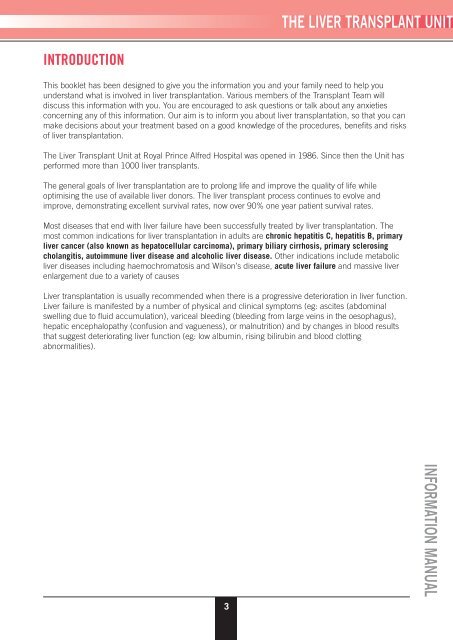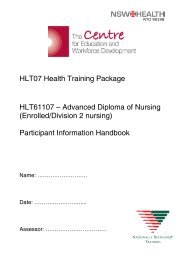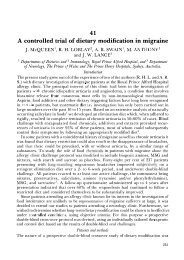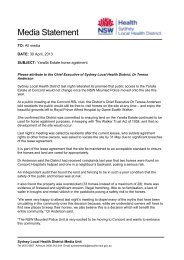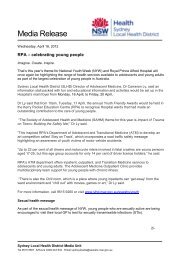information manual - for liver transplant recipients and their families
information manual - for liver transplant recipients and their families
information manual - for liver transplant recipients and their families
- No tags were found...
Create successful ePaper yourself
Turn your PDF publications into a flip-book with our unique Google optimized e-Paper software.
THE LIVER TRANSPLANT UNITINTRODUCTIONThis booklet has been designed to give you the <strong>in<strong>for</strong>mation</strong> you <strong>and</strong> your family need to help youunderst<strong>and</strong> what is involved in <strong>liver</strong> <strong>transplant</strong>ation. Various members of the Transplant Team willdiscuss this <strong>in<strong>for</strong>mation</strong> with you. You are encouraged to ask questions or talk about any anxietiesconcerning any of this <strong>in<strong>for</strong>mation</strong>. Our aim is to in<strong>for</strong>m you about <strong>liver</strong> <strong>transplant</strong>ation, so that you canmake decisions about your treatment based on a good knowledge of the procedures, benefits <strong>and</strong> risksof <strong>liver</strong> <strong>transplant</strong>ation.The Liver Transplant Unit at Royal Prince Alfred Hospital was opened in 1986. Since then the Unit hasper<strong>for</strong>med more than 1000 <strong>liver</strong> <strong>transplant</strong>s.The general goals of <strong>liver</strong> <strong>transplant</strong>ation are to prolong life <strong>and</strong> improve the quality of life whileoptimising the use of available <strong>liver</strong> donors. The <strong>liver</strong> <strong>transplant</strong> process continues to evolve <strong>and</strong>improve, demonstrating excellent survival rates, now over 90% one year patient survival rates.Most diseases that end with <strong>liver</strong> failure have been successfully treated by <strong>liver</strong> <strong>transplant</strong>ation. Themost common indications <strong>for</strong> <strong>liver</strong> <strong>transplant</strong>ation in adults are chronic hepatitis C, hepatitis B, primary<strong>liver</strong> cancer (also known as hepatocellular carcinoma), primary biliary cirrhosis, primary sclerosingcholangitis, autoimmune <strong>liver</strong> disease <strong>and</strong> alcoholic <strong>liver</strong> disease. Other indications include metabolic<strong>liver</strong> diseases including haemochromatosis <strong>and</strong> Wilson’s disease, acute <strong>liver</strong> failure <strong>and</strong> massive <strong>liver</strong>enlargement due to a variety of causesLiver <strong>transplant</strong>ation is usually recommended when there is a progressive deterioration in <strong>liver</strong> function.Liver failure is manifested by a number of physical <strong>and</strong> clinical symptoms (eg: ascites (abdominalswelling due to fluid accumulation), variceal bleeding (bleeding from large veins in the oesophagus),hepatic encephalopathy (confusion <strong>and</strong> vagueness), or malnutrition) <strong>and</strong> by changes in blood resultsthat suggest deteriorating <strong>liver</strong> function (eg: low albumin, rising bilirubin <strong>and</strong> blood clottingabnormalities).3INFORMATION MANUAL


